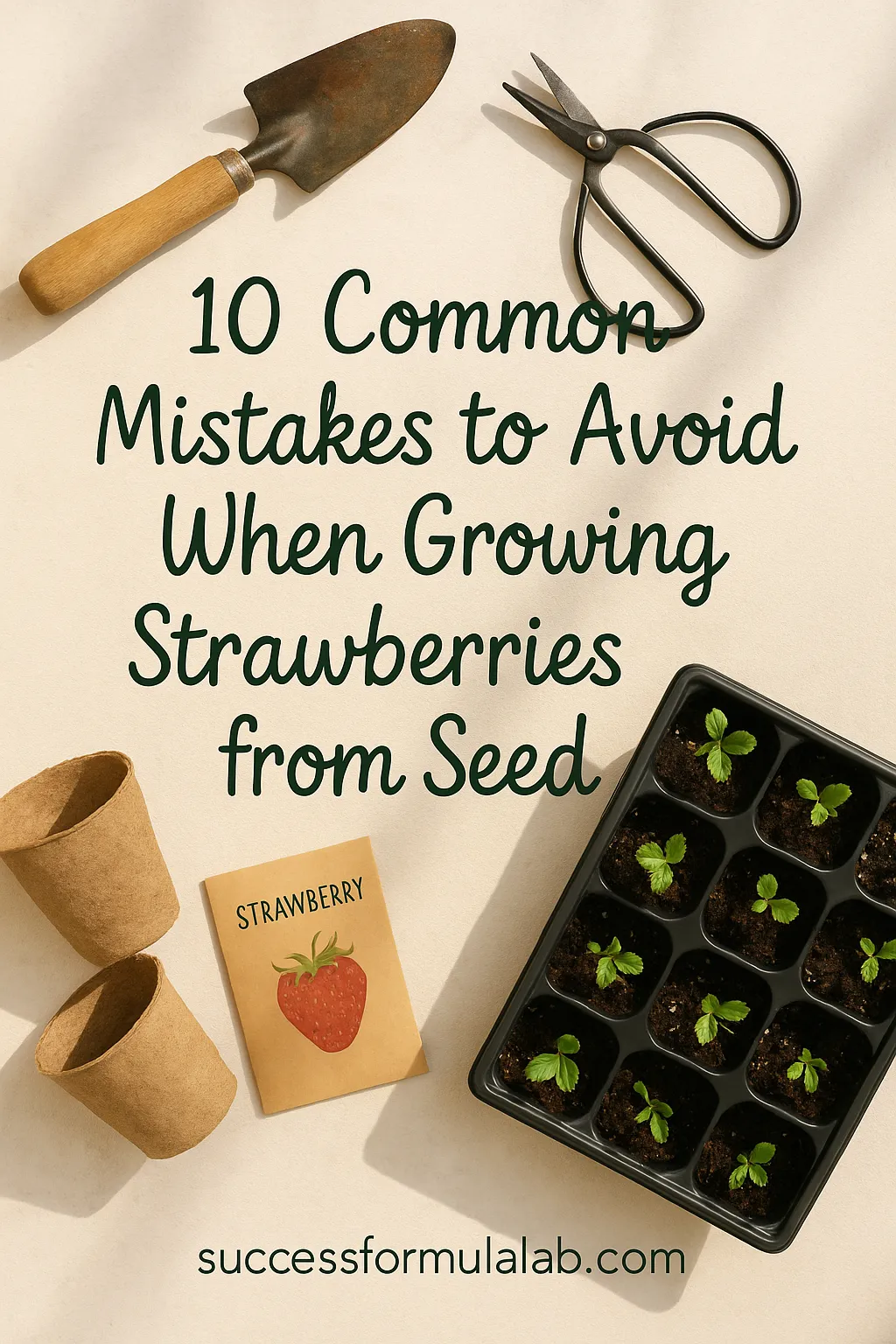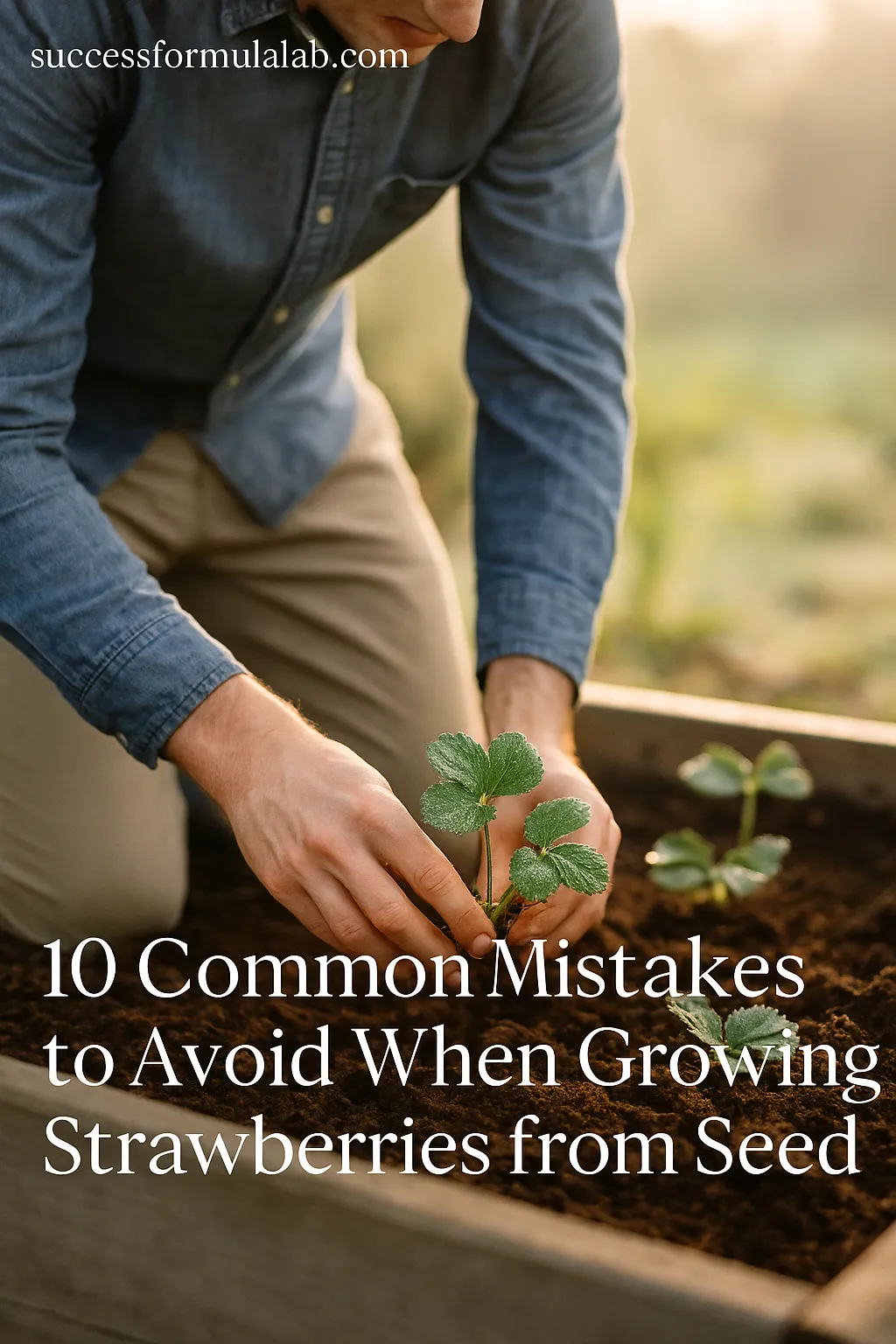Growing Strawberries from Seed Is Rewarding—If You Avoid These Pitfalls
You’ve likely tasted a juicy, sun-ripened strawberry and thought, “I’d love to grow these myself.” And while growing strawberries from seed may seem like a simple gardening task, it comes with its unique set of challenges. Maybe you’ve tried and failed, or you’re starting fresh and want to do it right the first time. Either way, avoiding the most common mistakes can save you time, money, and frustration—and help you grow sweet, vibrant berries in your own backyard.

This guide walks you through 10 mistakes that often derail first-time strawberry growers—and how to sidestep them to grow healthier, stronger plants.

Mistake #1: Using Old or Low-Quality Seeds
You might be tempted to use that dusty seed packet from two years ago, but strawberries have a relatively short shelf life. Poor-quality or expired seeds can lead to poor germination rates—or none at all.
What to Do Instead:
-
Always purchase your seeds from a reputable supplier.
-
Look for organic, non-GMO, or heirloom varieties with high germination rates.
-
Make sure the seeds are within their viability period (typically 2–4 years).
Mistake #2: Skipping Cold Stratification
Strawberry seeds need a period of cold dormancy to germinate properly. Ignoring this step drastically lowers your chances of seeing those first green shoots.
Quick Stratification Guide:
-
Place seeds in a damp paper towel.
-
Seal in a plastic bag and refrigerate for 2–4 weeks.
-
Label the bag and track your dates—consistency matters.
This cold stratification mimics winter and tells the seed it’s safe to sprout when you plant it.
Mistake #3: Planting Seeds Too Deep
Unlike larger seeds, strawberry seeds need light to germinate. Burying them too deeply is a common beginner mistake.
Proper Technique:
-
Lightly press seeds onto the surface of your seed-starting mix.
-
If needed, cover with the thinnest layer of vermiculite or fine soil dust.
-
Mist gently to keep moist without displacing seeds.
Germination Environment Table:
| Condition | Ideal Range |
|---|---|
| Light | Bright indirect or full |
| Planting Depth | Surface sow |
| Soil Temperature | 65–75°F (18–24°C) |
Mistake #4: Using the Wrong Soil Mix
Standard garden soil is too heavy and compact for strawberry seedlings. You need a light, airy mix that retains moisture without drowning the roots.
Best DIY Soil Mix:
| Ingredient | Purpose |
|---|---|
| Peat Moss | Holds moisture evenly |
| Perlite | Enhances drainage and airflow |
| Vermiculite | Supports seedling roots |
Avoid using compost-rich or clay-heavy soil, which can harbor mold or compact too tightly for sprouts.
Mistake #5: Overwatering
Too much water can kill young strawberry seedlings quickly. Soggy soil promotes mold, root rot, and fungus gnats.
Signs of Overwatering:
-
Leaves turning yellow or mushy
-
Mold or algae on soil surface
-
A damp, musty smell
Pro Tips:
-
Mist instead of pouring.
-
Let the top layer of soil dry slightly before re-watering.
-
Ensure containers have good drainage.
🌿 Tip for Self-Reliant Gardeners
If you’re serious about learning how to grow your own food, strawberries are just the beginning. Whether you’re working with a small backyard or planning full homestead independence, this practical self-reliance guide offers step-by-step strategies to grow a productive and sustainable garden, conserve water, and reduce your dependence on outside systems.
Mistake #6: Starting Seeds at the Wrong Time
Timing matters. Starting seeds too early or too late can disrupt the plant’s natural growth cycle and reduce your harvest.
When to Start:
-
Indoors: 8–10 weeks before your last expected frost date
-
Outdoors: Only after all risk of frost has passed and seedlings are strong
Use a planting calendar or seed-starting app to determine your best start date.
Mistake #7: Not Providing Enough Light
After germination, your seedlings will crave light—and lots of it. Without enough, they’ll grow long, leggy, and weak.
Lighting Options:
| Light Type | Efficiency | Recommended? |
|---|---|---|
| LED Grow Lights | High | ✅✅✅ |
| Fluorescent | Medium | ✅ |
| Natural Window | Varies | ⚠️ Only if south-facing |
Aim for 12–16 hours of light per day, and rotate trays to ensure even exposure.
Mistake #8: Not Thinning Your Seedlings
Overcrowding causes your seedlings to compete for nutrients, light, and air circulation—leading to weak plants and increased disease risk.
How to Thin:
-
Wait until seedlings have 2–3 true leaves.
-
Snip the weaker ones at the base with clean scissors.
-
Don’t pull—this can disturb roots of neighboring seedlings.
Mistake #9: Skipping Hardening Off
Transplant shock is real. Suddenly moving indoor plants into harsh outdoor conditions can stunt or kill them.
Hardening-Off Schedule:
-
Day 1–2: 1 hour outdoors, shaded
-
Day 3–4: Increase to 2–3 hours, partial sun
-
Day 5–7: Full sun exposure in increasing doses
-
Gradually transition over 7–10 days
This prepares your plants for wind, temperature swings, and direct sunlight.
Mistake #10: Transplanting Too Soon
If you transplant before your seedlings are ready, they may not survive the shock—or may stop growing altogether.
Signs of Readiness:
-
At least 2–3 sets of true leaves
-
Strong, visible roots that aren’t rootbound
-
Sturdy stems and healthy leaf color
Use biodegradable pots to minimize transplant disturbance and plant in the evening to reduce heat stress.
📌 Ready to Grow More Than Just Strawberries?

You’ve just learned how to avoid the most common strawberry seed-growing mistakes—what’s next?
If you’re ready to go beyond a small container garden and take charge of your own food system, The Self-Sufficient Backyard is your next step. This resource-packed guide shows you how to:
-
Grow food year-round—even in cold climates
-
Build DIY water systems and compost bins
-
Reduce grocery bills and dependence on big agriculture
-
Use every inch of your backyard to its full potential
❓ FAQ: Growing Strawberries from Seed
Is growing strawberries from seed hard?
It’s more delicate than using bare-root plants, but definitely achievable with proper care and attention to detail.
How long does it take to grow strawberries from seed to harvest?
Typically 5–6 months. Germination takes 1–6 weeks, followed by 3–4 months of growing time.
Do strawberries need light to germinate?
Yes. They should be surface sown and exposed to light for the best germination results.
Can I grow strawberries from seed indoors?
Yes! Start indoors in trays with proper lighting and then transplant them outdoors after hardening off.
Why didn’t my strawberry seeds sprout?
Common causes include old seeds, skipped cold stratification, or planting too deep. Proper light and soil moisture also matter.
Conclusion: Grow Smarter, Harvest Sweeter
Growing strawberries from seed can be deeply rewarding—but only if you avoid these beginner pitfalls. You now know how to give your seeds the best chance at life, from stratification to transplanting. With patience, planning, and a little dirt under your nails, your efforts will pay off in sweet, homegrown fruit—and the satisfaction of doing it yourself.
So grab your seeds, prep your soil, and start your strawberry journey today.
And if you’re ready to take your gardening—and your independence—even further, don’t forget to check out The Self-Sufficient Backyard to build your ultimate backyard food system.

